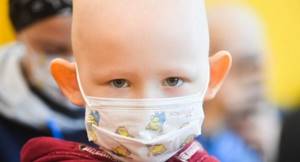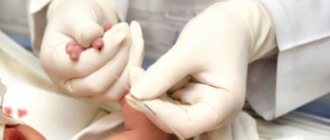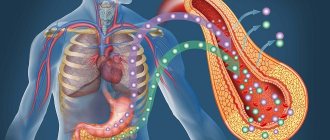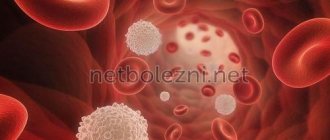Why are platelets in the blood determined in adults and children?
Platelet functions
Platelets belong to the formed elements of blood in the same way as erythrocytes and leukocytes.
The difference from them is that red and white blood cells have a cellular structure. Platelets are a kind of plates that do not have a nucleus. They are smaller in size than a red blood cell. In the blood, platelets are formed from a large precursor cell, the megakaryocyte.
Inside these blood cells there are substances that are stored in the form of granules. Due to these compounds, platelet functions are ensured.
The main function of blood platelets is to stop bleeding. The size of the vessel does not matter much: in small ones a plug is formed, and in large ones a clot of fibrin is formed.
That is, when the vessel wall is damaged, platelets protrude processes, facilitating the interaction of the plates with each other. Activated platelets release various clotting factors, triggering the process of clot formation from fibrin monomers.
In addition to participating in blood clotting processes, these formed elements have other functions:
- releasing biologically active substances, they contribute to the narrowing of the lumen of the vessel;
- regulate the permeability of the vascular wall for various compounds;
- indicate the place of attachment of the fibrin clot to the vessel wall;
- activate compounds that prevent the formation of a blood clot or promote clot splitting;
- support the structure and functions of the vascular wall;
- Platelet growth factors promote the movement of endothelial and smooth muscle cells, performing a so-called reparative function.
Platelets are synthesized in the bone marrow, then released into the bloodstream, where they remain for about a week and then die.
Norm of platelets in the blood of children
In children, the platelet count that should be normal is slightly different from the level in adults. In newborns, the norm is considered to be from 100 to 400 * 10 * 9 per liter. Then, up to a year, their content increases slightly: the lower limit of the norm is considered to be 150 * 10 * 9 per liter. Then the level of platelets in the blood reaches 180 - 320 *10*9 per liter.
Normal in adults
The normal level of platelets in the blood of an adult is 180 – 400 *10*9 per liter. Thus, as children grow older, the normal content of platelets in children reaches the level of adults.
Normal for pregnant women
In connection with the birth of the fetus, the mother's body has to rebuild. Therefore, a decrease in platelet levels in a pregnant woman is considered normal. For example, the normal level of blood platelets in the first trimester is considered to be 170 - 340 * 10 * 9 per liter.
Considering the important functions platelets perform, it is necessary to monitor their levels during pregnancy.
Functions of platelet cells
A specific feature of blood platelet cells is their ability to stick together and attach to the vascular intima due to special outgrowths (pseudopodia).
As a result, primary platelet clots are formed, which play an important role in the process of stopping bleeding.
Normally, the number of platelet cells in the blood can change significantly due to stressful situations, physical activity, exposure to a painful stimulus, viral and bacterial diseases (high platelets in a child under one year old are often associated with a past infection), etc.
It should be noted that in the implementation of the main function of platelets (participation in hemostasis processes), the presence of platelet cells on the granules and membrane surface plays an important role:
- specific platelet factors (partial thromboplastin, antiheparin factor, thrombostenin);
- vasoconstrictor factors (serotonin, adrenaline, norepinephrine);
- thromboxane;
- circulating immune complexes, etc.
The participation of platelets in the formation of immune responses is due to their phagocytic activity, the content of IgG, lysozymes and beta-lysines (lysozyme and beta-lysine are capable of destroying the membranes of some bacterial cells).
- Platelets - their role in the body and what threatens a deviation from the norm (increase or decrease in platelets)
Platelets also contain specific peptide factors that can stimulate the transformation of “null” lymphocyte cells into mature T- and B-lymphocyte cells.
Due to this, in case of vascular injuries, platelet cells not only help stop bleeding, but also prevent pathogenic microorganisms from entering the body.
Watch this educational film about platelets with your child:
In what diseases does the platelet count in the blood change?
Increasing
A high number of platelets in the blood can trigger the formation of clots, then blood clots in the vessels, which will lead to disruption of blood flow through them.
The reasons for a high concentration of blood platelets may be:
- neoplasms in the place of synthesis and maturation of all formed elements - the bone marrow;
- polycythemia is a disease that is accompanied by an increase in the number of all blood elements, including platelets;
- the presence of an infectious process in the body;
- there is no possibility of old plates being destroyed due to the absence of an organ (spleen) where this happens to them;
- kidney dysfunction;
- autoimmune pathology;
- with loss of large volumes of blood. This gives impetus to the synthesis of new cells and in large quantities to replenish what was lost.
Thus, a high platelet count in the blood is dangerous due to the occurrence of thrombosis.
Decreases
A decrease in the number of blood platelets can lead to serious consequences, including death. Therefore, it is impossible to allow a decrease in the level of formed elements.
A lack of platelets in the blood can lead to bleeding. It will also be difficult for the body to stop it. And a person can die from blood loss.
Therefore, if a small number of platelets is detected, it is necessary to find out what could lead to this.
A low platelet count is commonly called thrombocytopenia.
Thrombocytopenia may be caused by:
- increased destruction of these formed elements in the spleen;
- disruption of their synthesis in the bone marrow;
- infectious process;
- oncological diseases;
- the appearance of antibodies - specific molecules to platelets, which contribute to their rapid destruction, reducing their lifespan.
Uncontrolled use of blood thinners can lead to low platelet levels.

General blood test - transcript online
Using the online test interpretation service, you can check your results in a general blood test.
We take into account both the patient's gender and age, since the results can vary greatly in these cases. All parameter maps were compiled using medical literature. To start working with the service, indicate the gender and age of the person and select the parameters that interest you. Do not self-medicate. At the first signs of illness, consult a doctor.
The reasons why platelets in a child’s blood are higher than normal can only be determined through diagnostic measures. The clinical picture for a violation of this nature will be rather nonspecific, therefore it is strongly not recommended to independently compare the clinic and therapeutic measures. This is extremely dangerous for a child and can lead not only to complications, but also to death.
Diagnostically, an increase in platelets in a child’s blood is determined by laboratory tests. Instrumental diagnostics are carried out if necessary, depending on the current symptoms.
The prognosis is entirely individual, since everything will depend on the provoking factor and the age of the child, the state of his immune system.
What affects the platelet count in a healthy child?
Before the analysis, it is advisable not to take risks and not to overload the child with physical activity, to avoid injury. Emotional calm is also important.
A child's diet can also affect platelet levels. It is recommended to exclude fatty and smoked foods. Switch to a healthier diet.
Be careful with foods rich in vitamin C. They can thin the blood and change the level of detectable blood elements.
You should not take any medications on your own. Any medications should be prescribed only by a pediatrician or other doctor.
How to prepare properly
One of the important components when preparing for a general blood test is the emotional calm of mother and child.
Drawing blood is stressful and can lead to fluctuations in your readings, so it’s best to be mentally prepared for it. Blood must be donated on an empty stomach. But in infants this is difficult to comply with, so it is allowed to donate the material between feedings.
Also, the child’s hands should not be cold. At low temperatures, the capillaries spasm, blood flow slows down, and the procedure may be delayed.
It is important to sit or lay the child down so that he is comfortable.
Methods for determining the level of platelets in the blood
The study of the content of blood platelets is one of a number of indicators that are determined in a general clinical blood test. In a modern laboratory, this analysis is performed on an automatic hematology analyzer. As a rule, cell counting errors are kept to a minimum. But there are situations when a clot forms in the sample, which makes it impossible to count these plates.
The material for determining the level of blood platelets is blood taken from a vein or from a finger.
The solution in this situation is to count platelets manually. That is, a blood smear is prepared, it is painted with special dyes so that the plates are visible. After all the manipulations, the smear is examined under a microscope. 1000 red blood cells are counted, and in parallel, how many platelets were observed are noted. After which the calculation is made.
What is the platelet test called?
A test for platelets in a child is prescribed by a pediatrician, endocrinologist, surgeon, hematologist or infectious disease specialist and is included in the CBC (general blood test). According to indications, an extended study of the hemostatic system (coagulogram) can be performed.
Indications for analysis:
- poor blood clotting;
- tendency to thrombosis;
- hemorrhagic skin rashes;
- increased bleeding;
- frequent bruises of unknown etiology;
- diagnosis of infectious and other diseases.
Children should have the indicator determined at least once a year, and in the presence of diseases of the blood and coagulation systems much more often, according to the decision of the attending physician.
Platelets are determined as part of a general or clinical blood test during a standard examination. However, if the result reveals that the indicator exceeds the permissible values, then an additional cell count is carried out using the Fonio method. For this purpose, a microslide (blood smear) is prepared, which is stained and examined under a microscope. The doctor manually counts the number of blood cells. And for clinical blood analysis, automatic counters and automated devices are used.
Therefore, parents should know that the doctor does not write out referrals for platelets separately. A standard blood test is sufficient.
Normal mean platelet volume
Mean platelet volume (MPV) allows you to find out which types of PLT predominate in blood cells (mature or young). The MPV level is measured in femtoliters (hereinafter referred to as Fl).
The MPV value depends on the age criteria of the patient. So, the average level is 7-11 Fl. The maximum MPV value should be observed at the age of 1-5 years, and among children under one year of age, the indicators will be slightly reduced, since the hematopoietic system is not yet fully formed.
Table: MPV norm by age:
| Age, years | Norm MPV, Fl |
| Up to 1 | 7,1–8 |
| 1-5 | 8,1–8,9 |
| 5-60 | 7,4–12 |
These indicators differ in different laboratories. So, in one clinic the norm may be 6-13 Fl, and in another – 7.4-10 Fl.
Important! Blood is drawn from a vein. The result of the analysis is a histogram - a line indicating the ratio of young and mature cells.









